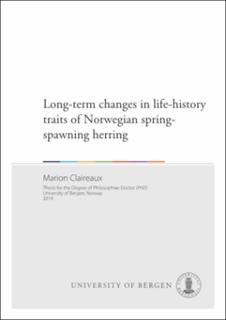Long-term changes in life-history traits of Norwegian spring-spawning herring
Doctoral thesis
Permanent lenke
https://hdl.handle.net/1956/18901Utgivelsesdato
2019Metadata
Vis full innførselSamlinger
Sammendrag
Life-history traits are key determinants of populations’ dynamics. Those traits are susceptible to natural selection and are therefore sensitive to the mortality regime and the selection pattern a population experience. Nowadays, almost all natural populations are affected by anthropogenic activities (e.g. urbanisation, loss or segmentation of habitats). More specifically, fish stocks, reproducing in the wild and coping with environmental fluctuations, have been exploited with industrialized efficiency for decades. The effects of fisheries on exploited stocks life-history traits have been widely studied and there is currently no doubt that fisheries-induced evolution is taking place in many of them. Fisheries-induced evolution of life-history traits constitutes a challenge for management, since genetic changes are difficult to reverse, and can lead to a loss of productivity and resilience of the exploited stock. Considering the amount of evidence supporting fisheries-induced evolution, it is therefore surprising that little of it is found in an intensively exploited pelagic fish, the Norwegian spring-spawning herring. Exploited for centuries, the stock collapsed in the late 1960’s because of overfishing and took more than 15 years to recover. The fishery went from an open-access fishery to a TAC regulated fishery combined with management regulations such as a minimum landing size of 25 cm. A weak decrease in age at maturation, maybe attributable to fisheries-induced evolution, has been detected, while other traits haven’t been studied yet. The goal of this thesis is to investigate how traits other than age and length at maturation have been affected by the fishing pressure in Norwegian spring-spawning herring. In addition, it gives an overview of how the selection pressures Norwegian Spring-spawning herring is subjected to may have changed during the last century and explain the weakness of the trends observed. Using multivariate linear (mixed effect) models together with data spanning 80 years, significant residual trends, potentially attributable to genetic changes, were found for the reproductive investment (increase, Paper II) and adult growth (decrease, Paper IV). No significant trend could be found in juvenile growth (Paper IV). However, the trends observed are weak and year to year variation is still mainly driven by environmental factors. In the case they stem from genetic changes, three possibilities could explain their weakness: (1) They are partly masked by phenotypic plasticity. (2) Changes in the selectivity experienced (Paper III) could slow down evolution rates. (3) The current selection pattern (Paper III) is driving the long-term trend. In addition, we showed that fishing can induce changes in natural mortality by selecting specific behaviours (Paper I), potentially leading to biased estimates for stock size assessment. However, it is not known how much of this pertains to Norwegian spring-spawning herring and warrants more research. The consequences of the observed trends in Norwegian spring-spawning herring lifehistory traits for the stock’s dynamics are not very clear yet. Even though slower growth could lead to a loss of productivity, consequences would not be as drastic as in stocks were age and size at maturation are largely reduced. Considering the current knowledge about fisheries-induced evolution, it seems that the modern management measures for the Norwegian spring-spawning herring stock are the most desirable and that the potential evolution shown in this thesis is of little consequence for the stock’s management compared to environmental variability. Close monitoring of the stock is however necessary to avoid or mitigate any detrimental effect fisheries-induced evolution could have in the future on the stock’s productivity and, most importantly, recovery potential.
Består av
Paper I: Claireaux, M., Jørgensen, C. & Enberg, K. (2018). Evolutionary effects of fishing gear on foraging behaviour and life-history, Ecology and Evolution. 8(22):10711-10721. The article is available at: http://hdl.handle.net/1956/18900Paper II: Claireaux, M., dos Santos Schmidt, T.C., Olsen, E.M., Varpe, Ø., Slotte, A., Heino, M., Enberg, K. (In prep). Eight decades of changes in herring reproductive investment: effects of fishing, environment and conspecific density. Full text not available in BORA.
Paper III: Claireaux, M., Folkvord, A., Heino, M., Enberg, K. (In prep). The Rosa Lee Phenomenon revisited: Population dynamics, sampling and selectivity affect the apparent changes in growth rate. Full text not available in BORA.
Paper IV: Claireaux, M., Zimmermann, F., Ernande, B., Heino, M., Enberg, K. (In prep) Reconstructing growth in Norwegian spring-spawning herring from scale increments: exploring historic population dynamics and their drivers. Full text not available in BORA.
